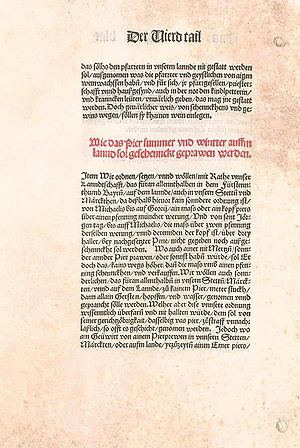
Regulations on brewing and serving beer adopted by the Bavarian “Landtag” (state diet) in 1516. Dukes Wilhelm IV (ruled 1508-1550) and Ludwig X (co-regent 1514-1545) issued them as part of the “Landesordnung” (general code of law) in the same year. There had been similar or identical regulations in Thuringian, Franconian and Bavarian communities since the beginning of the 14th century. The regulations insisting on high quality at a reasonable price strengthened the competitiveness of beer, so that it eventually replaced wine as a popular drink. The German term “Reinheitsgebot” (purity law) first appeared in the 20th century. The Purity Law, which still applies today to top and bottom-fermented beers brewed in Bavaria, is an essential cornerstone of the Bavarian brewing industry's self-image.
Term
Today, the term term “Reinheitsgebot” is associated above all with the regulation on the brewing of beer issued in 1516 in the Duchy of Bavaria. This is the result of an awareness process that began in the second half of the 19th century and merged the terms Bavaria, beer and purity law (of 1516) into one entity. The Purity Law of 1516 is probably the best-known purity law, but it is not the only one or even the oldest by far. The term “Reinheitsgebot” itself is an invention of the early 20th century. According to current knowledge, it was first used in 1909 in the Reichstag in Berlin on the Commission for Petitions of Government by Regierungsrat (government official) Joseph Rheinboldt (1860-1931) from the Reichsschatzamt (Imperial Treasury) in connection with a dispute about the legality of a certain brewing process. Previously one spoke of "surrogate prohibition"; the Middle Ages and Early Modern Period did not have a word of their own for the rules and prohibitions in brewing.
Older Purity Laws and their Causes
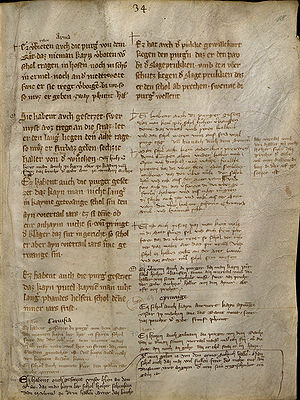
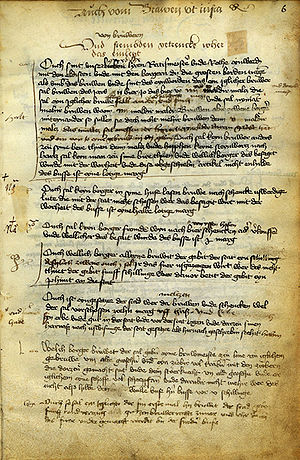
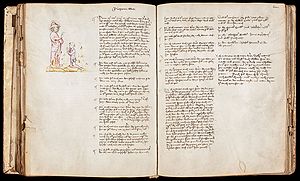
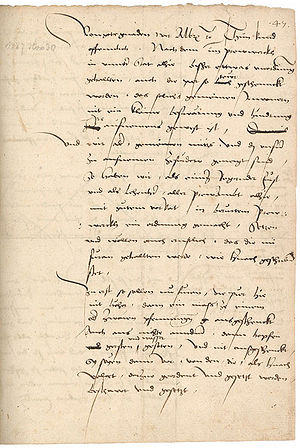
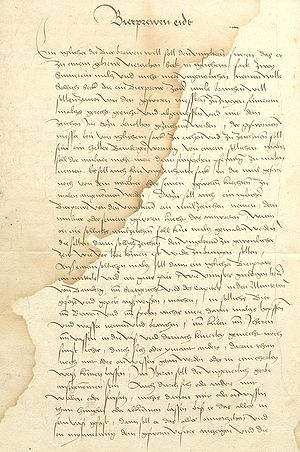
In the late Middle Ages, beer was brewed commercially mainly in the cities. It is therefore not surprising that the first brewing ordinances or purity laws appear in the municipalities' statutes. There is already a penalty for brewers who brew bad beer in Augsburg's city charter of 1156. Between 1302 and 1305, the imperial city of Nuremberg regulated the price of beer and the exclusive use of barley for the brewing process. More comprehensive early regulations are known from Weimar (1348, only malt and hops, no sempervivum or resin), Landshut (1409, only oat and barley malt and hops based on advice from brewing experts), Weißensee in Thuringia (1434, malt, hops, water), Regensburg(1447, ban on additives), Munich (between 1453 and 1487, barley, hops, water) and again Landshut (1486, hops and barley, ban on certain ingredients). Such rules or prohibitions were not limited to Bavaria or the Empire, as the example of London (1484, water, malt, yeast) shows.
At the end of the 15th century, the sovereigns also became involved in the regulatory process (1487 Duke Albrecht IV [ruled 1465-1508] for Munich, 1489 the bishop and cathedral chapter for Bamberg). In these cases, however, the ordinances continued to apply only to the municipalities, but in 1493 Duke Georg der Reiche (ruled 1479-1503) regulated for the Duchy of Bavaria-Landshut for the first time that brewers who used additives other than malt, hops and water were threatened with penalties.
Towards the end of the 15th century, it became clear that barley, hops and water (1486 Landshut, 1487 Munich) and malt, hops and water (1489 Bamberg) were best suited for the brewing process. Beers brewed in this way drove out other beers, such as mead, which was obtained from fermented honey water, or Grutbier (also called Greußing), which was brewed from malt in combination with special herbal mixtures. That barley was increasingly being relied upon was due to the fact that it was considered the most tasty and robust malt grain and was also quite inexpensive in the 15th century. In addition, other cereals such as wheat and rye should be reserved for bakers. For hops, the most important arguments were probably that they could be cultivated anywhere in a controlled manner and that they killed off unwanted harmful germs; beer could thus be made to last longer. This, together with the increasingly used bottom-fermented brewing method for brown beer, boosted production and thus consumption.
There were various reasons for the issuance of so-called purity laws. The expansion of the brewing industry in the 15th and 16th centuries was always accompanied by complaints about bad, undrinkable beer. Therefore, in the spirit of “gute Policey” (good rule) prevalent at the time, measures were taken in favour of consumers in order to promote the “gemeine Nutzen” (common good). In today's words, their purpose was quality assurance and food control (prohibition of harmful ingredients), security of supply for the population and price control (regulations of maximum price). However, aspects of fiscal and economic policy also have to be considered. Cities and sovereigns wanted to collect as much tax revenue as possible with the drink (“Aufschlag” or “Ungeld”; i.e. a surcharge on the price as consumption tax; in the Duchy of Bavaria, however, only since 1572). They therefore considered it their duty to lay down rules for the manufacture of a good and drinkable product. They also wanted to strengthen their brewers against increasing competition from the countryside. Aristocrats were opening more and more breweries there.
The Purity Law of 1516: Origin, Content and Control
The unification of the Wittelsbach constituent duchies of Bavaria-Munich and Bavaria-Landshut (1505/06) to form the Duchy of Bavaria was accompanied by a quest for legal standardisation. At the Landtag in Ingolstadt in April 1516, Dukes Wilhelm IV (ruled 1508-1550) and Ludwig X (ruled 1514-1545), who ruled together, agreed on a comprehensive “Landesordnung” (general code of law) with the united estates of Lower and Upper Bavaria (clergy, nobility, cities). In the fourth section under the provisions on "Policey-Sachen” (matters of public order), you will find what is probably the most famous outcome of the Landtag, entitled: "How beer should be poured and brewed in the country in the summer and winter." This is initially about setting a maximum price for the winter beer (one Munich penny per "Maß") and the summer beer or “Mertzen-Bier” (i.e. “March beer”; two pennies). Only afterwards the stipulation follows: "We also particularly want that for no beer brewed anywhere in our cities, market towns and in the countryside anything else shall be taken and used but barley, hops and water alone." Karin Hackel-Stehr attributes the inclusion of these provisions in the “Landesordnung” to the initiative of the cities, as places of commercial brewing, at the Landtag.
The ordinances of 1487 (Munich) and 1493 (Duchy of Bavaria-Landshut), which were also issued by the sovereigns, may be regarded as direct Old Bavarian models. The new ordinance of 1516 should now apply to the entire united Duchy of Bavaria and cover not only the cities but also the entire rural area; a quantum leap in the sphere of influence. Beyond the actual purpose, which serves the consumer above all, the enactment of a countrywide provision may be regarded as a further development step in the incipient shaping process of the early modern territorial state.
The Purity Law of 1516: Further Development and Control
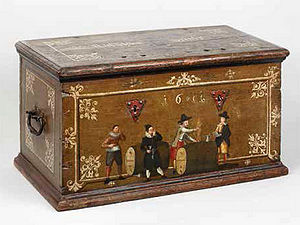
In 1533, the Duchy of Palatinate-Neuburg and the Upper Palatinate adopted the so-called Purity Law by passing identical beer regulations. The authorities' regulations not only reacted to changes in consumer habits, they - and the statewide regulation of 1516 in particular - also strengthened the competitiveness of beer, so that it was finally able to replace wine as the main drink in the 16th century. This may also have been due to a withdrawal of viticulture for climatic reasons, inflation for good wine and the increasing lack of acceptance for simple wines.
The Purity Law was exposed to various challenges again and again over the following decades and centuries. As early as 1520, in the revised version of the “Landesordnung”, it was stated, in response to protests by brewers, that the price of beer could be revised annually depending on the price of grain. One still reads of the brewers' demands to be allowed to increase the beer price again and again later. Additives continued to be discussed as well. In a ducal decree of 1551, coriander and laurel were permitted but other dangerous substances were prohibited. In 1553, the ducal councillors even proposed the addition of herbs and spices to save hops and barley during the brewing process.
The estates successfully objected. They insisted on the pure purity requirement for quality reasons. Other regulations were included in the “Polizeiordnung” (statute of public order) by Duke Maximilian I (ruled 1598-1651, Elector from 1623) in 1616. In it he renewed the Purity Law and expressly penalized the addition of (certain) herbs and seeds, including those mentioned by name. However, in the future, it should be permitted to use salt, juniper and caraway seed when boiling in moderation. Thus the Purity Law was at least modified, even if the state order of 1658 again speaks only of water, barley and hops.
The 15th century municipal purity laws mentioned above always had mechanisms of quality control, e.g. the city of Munich established a beer inspection commission in 1491. However, these precautions were missing in the "Landesordnung" of 1516. Beer inspection in the Duchy of Bavaria was first regulated in 1530 and is then to be found in all other state ordinances. Countless complaints about bad and harmful beer in the Early Modern Period show that this was necessary despite the Purity Law. On the other hand, in many southern German territories, this was reflected in a series of manorial mandates in the 18th century, which demanded good and healthy beer at a reasonable price. Brewers or innkeepers who offered undrinkable beer were punished, among other things, by publicly "knocking the bottom out of the barrels" and the brew flowing into the alleys.
The production of top-fermented wheat beer, which emerged in the late 15th century, was basically forbidden because wheat was used. However, two Lower Bavarian noble families were allowed to brew wheat beer by ducal privilege (1548 the Degenberg, 1586 the Schwarzenberg). After the Degenberg family died out in 1602, Duke Maximilian I. took over the monopoly on wheat beer and developed the wheat beer brewing industry into a profitable state-owned enterprise. Hofbrauhäuser (court breweries) and Kommunbrauhäuser (municipal communal breweries) (for wheat beer and brown beer) in the entire Bavarian region became a symbol of the expansion of the brewing and beer trade.
Reception and Legal Regulations in the 19th and 20th Centuries
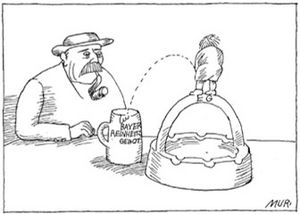
The Purity Law still applied after the end of the Old Empire in the Kingdom of Bavaria, which was now extended to the Swabian and Franconian territories. However, this was first recorded in writing in a recess of the Landtag in 1861 that prohibited the use of other substances or surrogates than barley malt and hops for brown beer. This purity requirement for beer was also supported by Bavarian criminal law, which punished the addition of foreign and hazardous substances to food and beverages with a prison sentence of up to two years (Criminal Code 1861).
Legislation in the 19th century primarily pursued fiscal rather than food law objectives. The regulation of 1811 was intended to protect consumers from bad and above all expensive beer (determination of the proportion of barley malt per brew in conjunction with a maximum price). Otherwise, however, it was intended in particular to secure tax revenue from the excise on beer for the Treasury and a share of the profits for the brewers. The 1868 Malt Excise Act also contained core provisions of the Purity Law by banning malt substitutes and stipulating that only malt obtained from barley should be used to produce brown beer.
In the preliminary discussions on this law, a completely new, forward-looking aspect emerged. Concerned about the additives and surrogates made possible by new chemical developments, politicians discussed the need to "prevent alteration and degeneration in the nature of Bavarian beer". This is the beginning of a development in which beer brewed according to the Purity Law was identified with Bavaria and at the same time represented the country as a cultural asset worthy of protection (Hermann).
The Bavarian Purity Law initially survived the foundation of the German Empire in 1871 with the supremacy of imperial law only to the extent that Bavaria was able to obtain a prerogative for its particular malt or beer tax in the Empire's constitution. As a result, the 1868 Malt Excise Act continued to apply to Bavaria. In addition, the Imperial Court of Justice in Leipzig fully supported the Bavarian Purity Law in several judgements on Bavarian beer adulteration scandals (1884). This was expressly and comprehensively anchored in law in the 1910 amendment to the Bavarian Malt Surcharge Act. In Article 2 it says: "The use of substances other than malt (kiln- and airdried), hops, yeast and water for the preparation of beer is prohibited."
At Empire level, the Purity Law was first enshrined in the "German Beer Tax Act" in 1906. This is also how it found its way into the rest of the Empire. However, since the purity requirement laid down by law was to only apply to bottom-fermented beer, while sugar and sugar-based colouring remained permissible for top-fermented beer, Bavaria and other southern German states (including Baden, Württemberg and Saxony-Coburg) insisted on their reserved rights. In the Weimar Republic, Bavaria joined the North German beer tax area in 1919 on the basis of the Beer Tax Act of 26 July 1918; however, as an exception, Bavaria was able to achieve the continued validity of the purity requirement for both bottom and top-fermented beer and even extend it to house brewers. In the relevant debates in the Bavarian Landtag, the term "purity law" appears again and prominently as a law that has always been sacred to the Bavarians. In 1924, the addition of sugar or sweeteners was even expressly prohibited in Bavaria.
This legal situation has basically not changed since then. With reference to the regulations of 1918/19 and the Federal Republic of Germany's Beer Tax Act of 1952, Section 3 of the Durchführungsverordnung des Vorläufigen Biergesetzes (Implementation Regulation of the Provisional Beer Act) (last published in BGBl Part I [2000], 1686) continues to guarantee the Bavarian “Sonderweg” (special path) of the absolute purity requirement. Bavarian breweries are therefore still prohibited from using sugar or colouring agents as additives for top-fermented beer. Despite fierce protests that have been resurfacing repeatedly since the 1950s (Sweet Beer War in the 1950s and 1960s, European Beer War 1958-1997), it was not possible to prevent the sale in Bavaria of beer from northern Germany or Europe that was not produced in accordance with the Bavarian Purity Law due to the priority given to the the free movement of goods in the common market.
The Deutsche Brauer-Bund (German Brewers' Association) has celebrated the "Day of German Beer" every year on 23 April since 1994. The Purity Law, allegedly the oldest continuously applied food law in Germany, is used here specifically as an advertising medium and as a means of cultivating the image of the Bavarian and German brewing industry.
References
- Günter Albrecht, Königliche Braukunst. Die Wittelsbacher und das Bier, Rosenheim 2006.
- Günter Dippold, Kraftspender und Renommiergetränk – zur Geschichte des Bierkonsums vom ausgehenden Mittelalter bis zum 19. Jahrhundert, besonders in Franken, in: Wolfgang Wüst (Hg.), Regionale Konsumgeschichte. Vom Mittelalter bis zur Moderne (Franconia. Beihefte zum Jahrbuch für fränkische Landesforschung 7), Erlangen 2015, 47-64.
- Ursula Eymold (Hg.), Bier. Macht. München. 500 Jahre Münchner Reinheitsgebot in Bayern, München 2016.
- Karl Gattinger, Bier und Landesherrschaft. Das Weißbiermonopol der Wittelsbacher unter Maximilian I. von Bayern (1598-1651), München 2007, 42-45.
- Karin Hackel-Stehr, Das Brauwesen in Bayern vom 14. bis 16. Jahrhundert, insbesondere die Entstehung und Entwicklung des Reinheitsgebotes (1516), Bonn-Bad Godesberg 1989.
- Karin Hackel-Stehr, Der Erlaß des Reinheitsgebotes von 1516. Motive, Hintergründe und Auswirkungen, in: Jahrbuch der Gesellschaft für die Geschichte und Bibliographie des Brauwesens 1991/92 (1992), 13-21.
- Hans-Georg Hermann, Das Reinheitsgebot von 1516. Vorläufer, Konflikte, Bedeutung und Auswirkungen, in: Reinhard Riepertinger u. a. (Hg.), Bier in Bayern. Katalog zur Bayerischen Landesausstellung 2016 (Veröffentlichungen zur Bayerischen Geschichte und Kultur 65), Augsburg 2016, 25-35.
- Alfons Jehle, Das Bier in Bayern. Kurzgefaßte geschichtliche Darstellung des Entwicklungsganges des bayerischen Brauwesens (Geschichtsbilder aus dem Bayerischen Brauwesen 1), München [1948].
- Franz Meußdorffer/Martin Zarnkow, Das Bier. Eine Geschichte von Hopfen und Malz, München 2014.
- Michael Nadler, Reinheitsgebot und Staatssäckel, in: Reinhard Riepertinger u. a. (Hg.), Bier in Bayern. Katalog zur Bayerischen Landesausstellung 2016 (Veröffentlichungen zur Bayerischen Geschichte und Kultur 65), Augsburg 2016, 144-146.
- Reinhard Riepertinger u. a. (Hg.), Bier in Bayern. Katalog zur Bayerischen Landesausstellung 2016 (Veröffentlichungen zur Bayerischen Geschichte und Kultur 65), Augsburg 2016, 147-163 (Exponate zum Reinheitsgebot).
- Klaus Rupprecht, Das "Bamberger Reinheitsgebot". Bestandteil der Ungeldordnung von 1489, in: Bericht des Historischen Vereins Bamberg 151 (2015), 73-86.
- Ernst Schubert, Das bayerische Reinheitsgebot von 1516 oder: Wie falsche Geschichtsdeutungen Geschichte machen können, in: Ernst Schubert (Hg.), Essen und Trinken im Mittelalter, Darmstadt 2006, 228-231.
- Birgit Speckle, Streit ums Bier in Bayern. Wertvorstellungen um Reinheit, Gemeinschaft und Tradition (Münchner Beiträge zur Volkskunde 27), Münster u. a. 2001.
- Erich Stahleder, Bayerische Bier-Acta: Fünfhundert Jahre Reinheitsgebot. Vortrag am 16. Juli 1983 auf der Burg Trausnitz ob Landshut, München 1983.
- Erich Stahleder, Gerste, Hopfen und Wasser. Das Münchner Reinheitsgebot von 1487 und das Reinheitsgebot von 1516 im Rahmen der bayerischen Braugeschichte, München 1987.
- Erich Stahleder, 500 Jahre Landshuter Reinheitsgebot, in: Jahrbuch der Gesellschaft für die Geschichte und Bibliographie des Brauwesens 1993, Berlin 1993, 55–66.
Sources
- Monika Ruth Franz (Bearb.), Die Landesordnung von 1516/1520. Landesherrliche Gesetzgebung im Herzogtum Bayern in der ersten Hälfte des 16. Jahrhunderts (Bayerische Rechtsquellen 5), München 2003.
- Heinrich Zapf, Das Bayerische Malzaufschlagsgesetz vom 18. März 1910 mit Ausführungsbestimmungen und Erläuterungen, München 1911.
- Heinrich Zapf/Erich Siegert, Das Biersteuergesetz vom 9. Juli 1923/11. August 1923/13. Februar 1924, mit Ausführungsbestimmungen, Nebengesetzen und Erläuterungen, Berlin/München 1925.
Further research
External links
- bavarikon: Themenschwerpunkt "Quellen und Darstellungen zum Münchener Oktoberfest", Kapitel "Die Stadt, das Land und das Bier"
- Bayerische Landesbibliothek Online (BLO): Bayerisches Brauer-Journal
- Bayerischer Brauerbund: Informationen zum Reinheitsgebot
- Biersteuergesetz der Bundesrepublik Deutschland, 2009
- Bierverordnung, 2005
- Verordnung zur Durchführung des Vorläufigen Biergesetzes der Bundesrepublik Deutschland, 1993
- Vorläufiges Biergesetz der Bundesrepublik Deutschland, 1993
Related articles
Cite
Klaus Rupprecht, Purity Law, 1516, published 28 July 2016, english version published 9 March 2020; in: Historisches Lexikon Bayerns, URL: <http://www.historisches-lexikon-bayerns.de/Lexikon/EN:Purity_Law,_1516> (21.12.2025)
